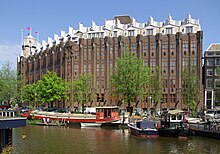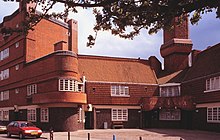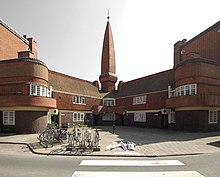Amsterdam School (architecture)
The Amsterdam School is a Dutch architectural style of classical modernism , especially expressionist building . The current is based on the architecture of Berlage , whose traditionalism was later criticized by Michel de Klerk .
Just like various buildings that arose in northern Germany during the same period, most of the buildings of the Amsterdam School are also referred to as brick expressionism.
development






The name “Amsterdamse School” goes back to the Dutch architect Jan Gratama (1877–1947), who in 1916 used it to describe a group of young architects who saw themselves in the tradition of Hendrik Petrus Berlage in their architectural style and aesthetic goals .
The leading architects are considered to be Michel de Klerk , Joan van der Mey and Piet Kramer , all of whom worked in Eduard Cuyper's office until 1910 .
The Scheepvaarthuis by Joan van der Mey, which was built from 1913 to 1916 in collaboration with Michel de Klerk and Piet Kramer, is seen as the beginning of the Amsterdam School . It is the prototype of a dynamic style that goes against the statics of Berlage's buildings. The brick building has a multitude of intricately masonry patterns, decorative gables , artificial glass , ironwork, reliefs and sculptures made of natural stone such as granite or marble. The interior was designed by the interior designer Theo Nieuwenhuis (1866–1951).
Due to the strong structure of the facade, even large buildings do not have a massive character, but appear varied and dynamic.
Important impulses came from the city of Amsterdam itself, which was the first city to issue a building ordinance in 1905 and hired van der Mey for the special position of an “ aesthetic advisor” to ensure artistic unity.
Many of the Amsterdam School's buildings are in Amsterdam-South ( Plan Zuid ) based on the urban design by Berlage. The following buildings are located in different parts of the city: The Olympic Stadium (next to the Olympic House ) by Jan Wils in Amsterdam-South, the Scheepvaarthuis by Johan van der Mey in the center, the house in the Spaarndammerbuurt by Michel de Klerk and the school building, etc. a. by Cornelis Kruyswijk and Nicolaas Lansdorp in Amsterdam-West. In the garden cities of “Oostzaan” and “Nieuwendam” in Amsterdam-Noord (by Berend Tobia Boeyinga, among others ), the Amsterdam School presents itself in a rural version. Boeyinga built some Reformed churches in this style.
In other cities you can find a. Buildings by Willem Marinus Dudok in Hilversum or Park Meerwijk in Bergen . The Bijenkorf in The Hague by Piet Kramer (1924–1926) is considered to be the last major work of the Amsterdam School.
De Klerk died in 1923. The Amsterdam School had thus passed its peak, even if the architectural style with Piet Kramer as one of the most important architects of the Amsterdam School continued until the early 1930s.
The journal Wendingen ("Changes"), the organ of the association of Architectura et Amicitia , appeared in 116 issues between 1918 and 1931 and was considered the magazine of the Amsterdam School.
Since 2001 there has been a museum in Michel de Klerk's Het Schip residential complex , which presents a lot of information about the Amsterdam school.
Importance of the Amsterdam School
While in the first half of the 20th century the architecture of the Amsterdam School was rejected as outdated by the CIAM rationalists and the CIAM secretary Sigfried Giedion , in the meantime the opinion of this architectural trend has changed significantly in a positive sense. The architecture author Vittorio Magnago Lampugnani, for example, describes Berlage's urban development plan and the architecture of the Amsterdam School in his publications “The City in the 20th Century” as a good example. In doing so, he distances himself from many earlier interpreters of architecture.
As early as the 1930s there were individual New Building architects who recognized the relative value of Berlage's urban development with the Expressionists. In the early 1930s, Le Corbusier visited the Netherlands and wrote an enthusiastic 6-page article entitled “Winterreise nach Holland” in the magazine “Plans” No. 12 of February 1932. There were passages in this article like: “Land of undertakings "," Gigantic efforts of urban development "and" the standards are those of a whole and the districts are built all at once ". By this, Le Corbusier was not referring to the small white settlements by architect Oud , but to the city extensions of Amsterdam based on the urban development plans by Berlage and the architecture plans of the Amsterdam School. Furthermore, one has to imagine that the city extensions of the CIAM rationalists Cornelis van Eesteren and Ben Merkelbach were built much later, the first part of Bos en Lommer in the years 1938–1949. The fact that Berlage was invited to the first CIAM congress in 1928 was a recognition of his urban planning work. Perhaps Berlage received this invitation on behalf of Le Corbusier or like-minded architects. The above-mentioned and translated passages are in the book "Die Funktionelle Stadt" by Thilo Hilpert, on page 230.
Buildings (selection)
- Brug 283 (1913–1914), bridge, Waalseilandsgracht / Buiten Bantammerstraat, Amsterdam
- Scheepvaarthuis (1913–1916), office building, Prins Hendrikkade, Amsterdam
- House block Eigen Haard (1914–1918), Spaarndammerplantsoen, Amsterdam
- Ir. DF Woudagemaal (1917–1920), steam pumping station, Tacozijl near Lemmer
- Het Schip (1917–1921), City Block, Spaarndammerplantsoen, Amsterdam
- PL Kramerbrug (1917-1921), Bridge, Amstelkade 1, Amsterdam
- Het Amsterdams Lyceum (1918–1920), School, Valeriusplein, Amsterdam
- Gebouw Batavia (1918–1920), office building, Prins Hendrikkade, Amsterdam
- De Dageraad (1918–1923) block , Takbuurt, Amsterdam
- Building A of Radio Kootwijk , (1920–1922), Apeldoorn municipality
- Holendrechtstraat 1-47 (1921-1923), Amsterdam
- Horticultural Laboratory (1921–1923), Wageningen
- Het Sieraad (1921–1924), school, Postjesweg, Amsterdam
- Bronckhorststraat 11-37 (1922-1924), Amsterdam
- Main Post Office Utrecht (1922–1924), Utrecht
- Berlage Lyceum (1923–1924), school, Takbuurt, Amsterdam
- Harm Smeengeschool (1924–1925), former school building, Amsterdam
- De Bijenkorf (1924–1926), department store, Grote Marktstraat, The Hague
- Huize Lydia (1924–1927), former girls' home, Roelof Hartplein, Amsterdam
- Coöperatiehof (1925–1928), Amsterdam
- Lyceumbrug (1926–1927), Bridge, Olympiaplein, Amsterdam
- Carlton Hotel (1926–1928), Vijzelstraat, Amsterdam
- Het Nieuwe Huis (1927–1928), Roelof Hartplein, Amsterdam
Holendrechtstraat 1–47 (1921–1923) in Amsterdam, architect: Margaret Staal-Kropholler
Bronckhorststraat 11–37 (1922–1924) in Amsterdam, architect: Jan Frederik Staal
literature
- Maristella Casciato: De Amsterdamse School. Uitgeverij 010, Rotterdam 1991, ISBN 90-6450-116-5 .
- Wim de Wit: The Amsterdam School. Dutch Expressionist Architecture, 1915-1930. MIT Press, Cambridge (Mass.) 1983, ISBN 0-262-04074-3 .
- Bernhard Kohlenbach: Pieter Lodewijk Kramer 1881–1961. Amsterdam School Architect. Wiese Verlag, Basel 1994.
Most editions of the Dutch architecture and art magazine Wendingen , published from 1918 to 1931, are regarded as “printed sources ” on the Amsterdam School .
Web links
- Amsterdam School (architecture). In: arch INFORM . (with project list)
- Museum Het Schip
- Cover design Wendingen (Dutch)
- Platform Wendingen (Dutch)
Individual evidence
- ↑ Bouwkundig Weekblad 45/1916 ( Memento of March 8, 2016 in the Internet Archive ) (PDF; 421 MB) (Dutch)
- ↑ Maristella Casciato: De Amsterdamse School. Uitgeverij 010, Rotterdam 1991, p. 9.
- ↑ Maristella Casciato: De Amsterdamse School. Uitgeverij 010. Rotterdam 1991, p. 47.
- ↑ Overview of the published editions in the article Wendingen in the English language Wikipedia





















